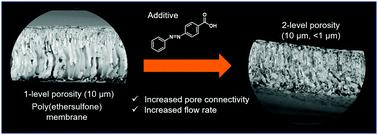当前位置:
X-MOL 学术
›
Mater. Chem. Front.
›
论文详情
Our official English website, www.x-mol.net, welcomes your feedback! (Note: you will need to create a separate account there.)
Dual-template approach to hierarchically porous polymer membranes
Materials Chemistry Frontiers ( IF 7 ) Pub Date : 2020-11-5 , DOI: 10.1039/d0qm00610f Thomas J. F. Southern 1, 2, 3, 4 , Rachel C. Evans 1, 2, 3, 4
Materials Chemistry Frontiers ( IF 7 ) Pub Date : 2020-11-5 , DOI: 10.1039/d0qm00610f Thomas J. F. Southern 1, 2, 3, 4 , Rachel C. Evans 1, 2, 3, 4
Affiliation

|
The non-solvent induced phase separation (NIPS) method is often used to fabricate porous polymer membranes that have a wide variety of applications in the fields of purification and energy materials. Such applications typically require membranes with a well-controlled pore structure across multiple levels of structural hierarchy. However, with the NIPS method, the membrane porosity is typically restricted to a single structural level due to the use of just one type of templating agent, commonly a polymer amphiphile. To overcome this limitation, here we report a new dual-template approach to embed multilevel porosity into poly(ethersulfone) membranes. In this approach, the polymer amphiphile Pluronic® F127 (F127) is used to template the higher level structure (10 μm scale), while a secondary molecular template, 4-(phenyl)azobenzoic acid (PABA), is simultaneously introduced to enable structural control at the 1 μm level. Analysis of the membrane structure by scanning electron microscopy revealed that F127 creates larger finger-like pores, while PABA introduced a more fibrous, interconnected porous sub-structure. Contact angle measurements showed that the PABA additive increases the hydrophilicity of the resultant membranes, while dead-end permeability measurements demonstrated that the hierarchical pore structure results in a 95% increase in permeability compared to a single level pore structure. Solvent extraction studies revealed that quantitative removal of the PABA template could be achieved, without any modification to the secondary level pore structure. This process offered the benefit of removing flakes of crystallized PABA from the larger, finger-like pores, leading to a further 300% increase in permeability. Given the simplicity and versatility of the NIPS method, this dual-template approach presents an efficient route to hierarchically structured, porous polymer membranes whose properties may be tailored for a targeted application.
中文翻译:

双模板方法用于分层多孔聚合物膜
非溶剂诱导相分离(NIPS)方法通常用于制造多孔聚合物膜,该膜在净化和能源材料领域具有广泛的应用。此类应用通常需要跨多个层次结构层次具有良好控制的孔结构的膜。然而,对于NIPS方法,由于仅使用一种类型的模板剂,通常是聚合物两亲物,膜的孔隙率通常被限制在单个结构水平。为了克服这一局限性,我们在这里报告了一种新的双模板方法,可将多级孔隙率嵌入聚(醚砜)膜中。在这种方法中,聚合物两亲F127(F127)用于模板化更高水平的结构(10μm规模),而次级分子模板4-(苯基)偶氮苯甲酸(PABA)同时引入可以实现1μm水平的结构控制。通过扫描电子显微镜对膜结构的分析表明,F127产生了较大的手指状孔,而PABA引入了更多的纤维状,相互连接的多孔子结构。接触角测量结果表明,PABA添加剂可提高所得膜的亲水性,而无端渗透率测量结果表明,与单级孔结构相比,分层的孔结构导致渗透率提高了95%。溶剂萃取研究表明,无需对二级孔结构进行任何修改,就可以定量去除PABA模板。此过程的好处是可以从较大的手指状毛孔中去除结晶的PABA薄片,导致渗透率进一步提高300%。鉴于NIPS方法的简单性和多功能性,这种双模板方法为构建分层结构的多孔聚合物膜提供了一条有效途径,其性能可针对目标应用进行定制。
更新日期:2020-12-10
中文翻译:

双模板方法用于分层多孔聚合物膜
非溶剂诱导相分离(NIPS)方法通常用于制造多孔聚合物膜,该膜在净化和能源材料领域具有广泛的应用。此类应用通常需要跨多个层次结构层次具有良好控制的孔结构的膜。然而,对于NIPS方法,由于仅使用一种类型的模板剂,通常是聚合物两亲物,膜的孔隙率通常被限制在单个结构水平。为了克服这一局限性,我们在这里报告了一种新的双模板方法,可将多级孔隙率嵌入聚(醚砜)膜中。在这种方法中,聚合物两亲F127(F127)用于模板化更高水平的结构(10μm规模),而次级分子模板4-(苯基)偶氮苯甲酸(PABA)同时引入可以实现1μm水平的结构控制。通过扫描电子显微镜对膜结构的分析表明,F127产生了较大的手指状孔,而PABA引入了更多的纤维状,相互连接的多孔子结构。接触角测量结果表明,PABA添加剂可提高所得膜的亲水性,而无端渗透率测量结果表明,与单级孔结构相比,分层的孔结构导致渗透率提高了95%。溶剂萃取研究表明,无需对二级孔结构进行任何修改,就可以定量去除PABA模板。此过程的好处是可以从较大的手指状毛孔中去除结晶的PABA薄片,导致渗透率进一步提高300%。鉴于NIPS方法的简单性和多功能性,这种双模板方法为构建分层结构的多孔聚合物膜提供了一条有效途径,其性能可针对目标应用进行定制。



























 京公网安备 11010802027423号
京公网安备 11010802027423号